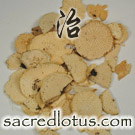Chuan Mu Tong (Clematis)
Herb 7 of 28 in Herbs that Regulate Water and Drain Dampness
Buy This Herb
Get free shipping from
our partners at CHD
our partners at CHD
Chinese Herb Actions
-
Promotes Urination, Drains Damp Heat
For urinary tract infections with painful dribbling due to damp-heat in the bladder. - Clears Heart Heat/Fire, Drains Fire Down
For sores of the mouth and tongue with irritability and scanty urine due to heat in the Heart which is cleared via the small intestine. - Promotes Lactation and Opens the Blood Vessels
For insufficient lactation, amenorrhea, and stiff painful joints.
Chinese Herb Contraindications & Cautions
- Do not use during pregnancy
- Do not use in cases with spermatorrhea, Yang deficiency, or Qi deficiency
Herb-Drug Interactions
- Chuan Mu Tong promotes urination and may interfere with Diuretic drugs.
Chinese Herb Toxicity & Overdose
- No toxicity noted
- Section not completed...
Chinese Herb Dosage
- None noted 12 3-6 grams in decoction 13
Chinese Herb Notes
- Chuan Mu Tong and Hu Po both drain fire from the Heart Channel and Small Intestine with pain or bloody urine. Both drain fire from the Heart but Chuan Mu Tong is more used for sores on the tongue while Hu Po calms spirit.
- Mu Tong can be sourced from both caulis akebiae and clematis armandii, but clematis is more common in the United States.
Chinese Herb Clinical Studies & Research
- Antinociceptive and anti-inflammatory effects of the saponin and sapogenins obtained from the stem of Akebia quinata.
Choi J, Jung HJ, Lee KT, Park HJ. J Med Food. 2005 Spring;8(1):78-85 - Tinnitus treated with combined traditional Chinese medicine and Western medicine
Yang DJ. Zhong Xi Yi Jie He Za Zhi. 1989 May;9(5):270-1, 259-60. - Toxicity of the Chinese herb mu tong (Aristolochia manshuriensis). What history tells us.
Zhu YP. Adverse Drug React Toxicol Rev. 2002;21(4):171-7.
This Herb Appears in the Following Formulas:
- Ba Zheng San (Eight Herb Powder for Rectification)
Category: Formulas that Clear Damp-Heat - Dang Gui Si Ni Tang (Tangkuei Decoction for Frigid Extremities)
Category: Formulas that Warm the Channels and Disperse Cold - Dao Chi San (Guide Out the Red Powder)
Category: Formulas that Clear Heat from the Organs - Gan Lu Xiao Du Dan (Sweet Dew Special Pill to Eliminate Toxins)
Category: Formulas that Clear Damp-Heat - Ju He Wan (Tangerine Seed Pill)
Category: Formulas that Promote the Movement of Qi - Long Dan Xie Gan Tang (Gentiana Longdancao Decoction to Drain the Liver)
Category: Formulas that Clear Heat from the Organs - Xiao Feng San (Eliminate Wind Powder from True Lineage)
Category: Formulas that Release Wind from the Skin and Channels - Xiao Ji Yin Zi (Cephalanoplos Decoction)
Category: Formulas that Clear Heat and Stop Bleeding






